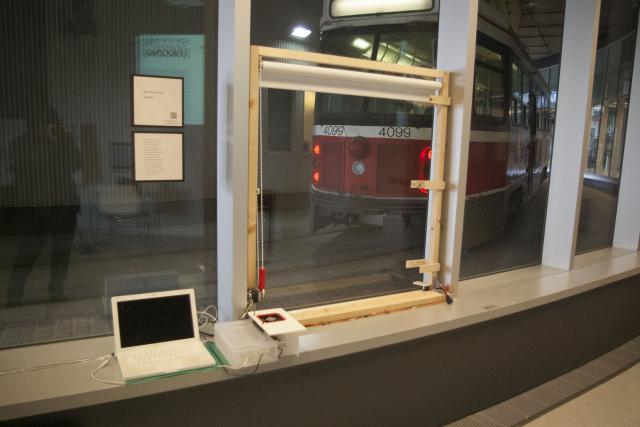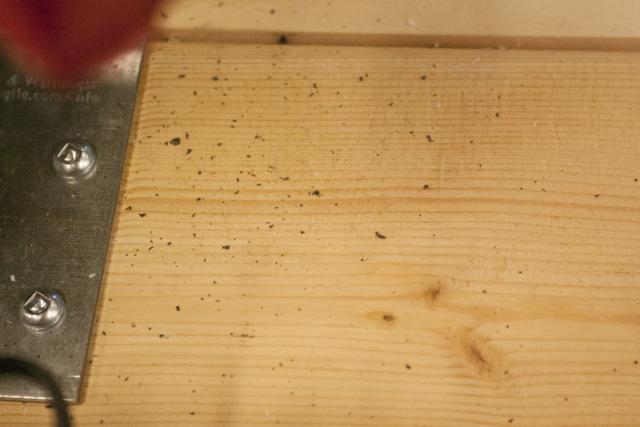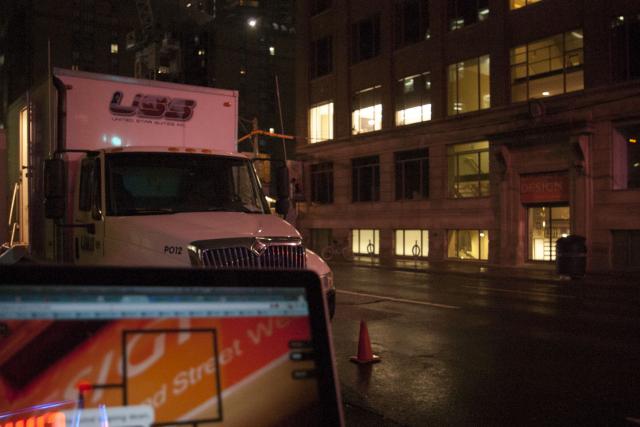Last week I tried to write up an exhibition proposal literally just half a day before the deadline. And this morning I got the curators’ decision: “Unfortunately we are unable to…”
I picked up my proposal in the afternoon and asked one of the curators if the concept was strong, and she said yes. It’s just that there were too many proposals and mine didn’t fit with any other. (And she’d have liked better and more visuals.)
Anyway, I hadn’t originally even dreamt of submitting a proposal. I knew it was a long shot. I tried anyway. It didn’t work out. I don’t think I’ll have another chance at trying again with this gallery, though; but I can try somewhere else when somewhere else puts out a call, I guess.
“Try things even if you don’t feel confident.”
That’s what I myself wrote after dropping off my proposal last week, on a list of advice for new students posted on some bulletin board on the second floor of the main building…
Now that the crazy week is over and the ceramics studio is not firing anything any more this semester, I’m hit with imminent multiple deadlines. I sure hope everything will be ok.
My professor said if our installation has held up for the duration of an exhibition, we are already doing better than many scientists. A comforting (and shocking) revelation notwithstanding, I am still not too satisfied that the (engineering part, so to speak, of the) design had not been conceived better.
William was calling me an “artist” today. Naturally I brushed it off. I know what we were called in the past week. But for multiple reasons that should be obvious, I still find this rather ironic.
We were chatting with Alex from IAMD last night at the closing reception (I believe “we” were myself, Brandon, and our prof), and Brandon and I told her “We don’t even have a studio.” Naturally, she was shocked…

Got here at 4:30pm (having missed my class at 12:00pm) and found that things were already being taken down. I used to really hate exhibitions being taken down before their advertised closing time; I guess I still hate it, but have to acknowledge that such is reality.
I just wish if people are tearing down at 4pm, they should have advertised today’s gallery hours as 12:00–4:00pm and not 12:00–5:00pm.

“Old media requires lubrication.”
This was one of the answers to the fake questionnaire I was given at
Night Kitchen during last year’s Nuit Blanche. Back then the answer didn’t really make much sense to me, and in fact I thought the answer was bizarre. But of course, I hadn’t been involved in any “old media” creation that would have required lubrication.
Imagine how I felt when I had left the installation turned on for the night and then discovered bits of the sprocket wheel on the wooden frame. I was so glad the wheel had not been destroyed.
So I guess I can now sympathize with that answer to that fake question: Old media
does require lubrication. It probably requires
daily lubrication, even. But does that mean our installation, with such a strong electronics component, is still “old media”? So “new media” is virtual only? I don’t know if I can side with this conclusion, yet.
(cropped)_1534.preview.JPG)
When people saw our
Blind Reading installation, they often ask, “How does it work?”
The fact that the piece is an art installation and not a design artefact must not be obvious. Even the speeches alluded to results of design research (when there is, as far as I can tell, only
one product design presentation in the whole exhibition). Even
the official blog of the exhibition sounds as if they got it wrong and thought our art piece was a design artefact.
But at least the installation held up for the evening. (The realization that, other than the incorrect wiring, the root cause of our problem was
mechanical in nature helped immensely.) People did ask, we tried to explain, and I hope we got our points across. I still fear Wednesday: I have never been on this side of the table at an artist’s talk before, and I have not gone to enough artist’s talks, but my consolation is that I will probably not be the one doing most of the talking.
There were people inside working on their artwork, and I was able to get in. Hopefully this will not take more than 8 hours…
One thing that we might have done wrong is to have connected a 3V stepper to the Adafruit motor shield and using a 5V supply. But on further investigation this might not be as simple as that.
According to
the data sheet, the 57BYGH420 is a unipolar stepper. However,
a page Google found suggests that 6-wire steppers can be connected either as a unipolar or bipolar motor. (It also tells me that our motor is a NEMA 23.) Indeed, according to
Stepper Motor Connection Options on piclist.com this is indeed the case, and to be precise 6-wires can be connected either as unipolars or a “bipolar-series.”
What’s interesting is that what Angela did to the two centre taps was in fact correct (whereas Adafruit’s documentation is not): To configure a 6-wire stepper as a bipolar, the two centre taps should “not [be] connected to anything.” That is probably why when I tried connecting the centre taps to GND (as per Adafruit’s instructions), the motor stalled.
It is also worth noting that the page says that if we connect a 6-wire as a bipolar, we get twice the resistance than as rated and 4 times the inductance, and require 70.7% the current and 141.4% the voltage. Which would mean the 57BYGH420 as a bipolar would be actually a 4.23V motor at 1.414A. So it in fact needs a supply that can deliver approximately 5.43V. Our 5V supply is low, but not by so much. A 6V, but not a 9V, will probably do better.
So apparently last night my Mac didn’t die; it’s just that the blinds were moving so slowly that the AJAX frontend thought the installation was not running.
But right now something really isn’t right: The last status message the web backend received was from 4:32pm. That was when I headed out to Active Surplus to buy some pulleys (which I never got to try installing because my professor was using the room when I came back. Sigh).
So, judging from that timestamp, I most likely had just forgotten to restart the python script. Or maybe the Mac really overheated this time, since the ssh process seems nowhere to be found either…

So I have been standing here, outside 240, filming the installation for the past half hour, and I just want to say that ths experience is entirely different from the experience I had inside, let alone the virtual experience on our web site.
The tweaked installation runs incredibly slow, almost imperceptibly slow. On the site that would be unbearable, but outside, on the actual official viewing spot, it is calming.
Well, the site is not even working. My old Mac must have overheated… Sigh…
Our professor was suggesting that we could document our experience of having a geographically separated team designing our gizmo for our installation. But I have this feeling that our biggest problem isn’t really our geography, it’s the simple lack of access.
Our biggest progress was made approximately during the last one and a half weeks, yet we saw several days where Angela was in town but we could not do any work on our installation either because the room was in use all day, or simply because the office separating the elevator lobby and our classroom was locked and no one was available to open that door for us. We literally wasted at least four days because we physically could not get into our own classroom (in a building we were told would have access 24 hours a day, 365 days a year).
It’s not the remote aspect; it’s the “last mile”—or, in our case, literally, the last inch (that is, the thickness of a locked door).
So I could not even mount a set of information panels I freshly made yesterday because when I got back (from the cold, outside, in Butterfield Park, because students in our program apparently have no access to proper, ventilated studio spaces, and for obvious reasons I was not going to use rubber cement or spray fixative in the only studio space I actually have access to—I don’t want to literally blow up the studio we all love) the door was already locked.
In hindsight, during our group meeting yesterday we could have easily defended our (unreasonable, I admit) slowness—we could not make any progress not because Angela was not in town, nor because I could not understand her code until I got my own Arduino, nor because of the steep learning curve of figuring out how to drive the stepper, nor even because the wheel was slipping and we could not make it not slip; we could not make progress simply because we could not get into the classroom to work on the installation.
This has to be the stupidest reason ever why work could not be done, but it’s true, and it’s sad. And it has absolutely nothing to do with us allegedly treating this “real-world commitment” as mere “schoolwork.”
And I fear this will repeat in our next installation, because 49 is another space we simply cannot get in.

 Got here at 4:30pm (having missed my class at 12:00pm) and found that things were already being taken down. I used to really hate exhibitions being taken down before their advertised closing time; I guess I still hate it, but have to acknowledge that such is reality.
I just wish if people are tearing down at 4pm, they should have advertised today’s gallery hours as 12:00–4:00pm and not 12:00–5:00pm.
Got here at 4:30pm (having missed my class at 12:00pm) and found that things were already being taken down. I used to really hate exhibitions being taken down before their advertised closing time; I guess I still hate it, but have to acknowledge that such is reality.
I just wish if people are tearing down at 4pm, they should have advertised today’s gallery hours as 12:00–4:00pm and not 12:00–5:00pm. “Old media requires lubrication.”
This was one of the answers to the fake questionnaire I was given at Night Kitchen during last year’s Nuit Blanche. Back then the answer didn’t really make much sense to me, and in fact I thought the answer was bizarre. But of course, I hadn’t been involved in any “old media” creation that would have required lubrication.
Imagine how I felt when I had left the installation turned on for the night and then discovered bits of the sprocket wheel on the wooden frame. I was so glad the wheel had not been destroyed.
So I guess I can now sympathize with that answer to that fake question: Old media does require lubrication. It probably requires daily lubrication, even. But does that mean our installation, with such a strong electronics component, is still “old media”? So “new media” is virtual only? I don’t know if I can side with this conclusion, yet.
“Old media requires lubrication.”
This was one of the answers to the fake questionnaire I was given at Night Kitchen during last year’s Nuit Blanche. Back then the answer didn’t really make much sense to me, and in fact I thought the answer was bizarre. But of course, I hadn’t been involved in any “old media” creation that would have required lubrication.
Imagine how I felt when I had left the installation turned on for the night and then discovered bits of the sprocket wheel on the wooden frame. I was so glad the wheel had not been destroyed.
So I guess I can now sympathize with that answer to that fake question: Old media does require lubrication. It probably requires daily lubrication, even. But does that mean our installation, with such a strong electronics component, is still “old media”? So “new media” is virtual only? I don’t know if I can side with this conclusion, yet.(cropped)_1534.preview.JPG) When people saw our Blind Reading installation, they often ask, “How does it work?”
The fact that the piece is an art installation and not a design artefact must not be obvious. Even the speeches alluded to results of design research (when there is, as far as I can tell, only one product design presentation in the whole exhibition). Even
When people saw our Blind Reading installation, they often ask, “How does it work?”
The fact that the piece is an art installation and not a design artefact must not be obvious. Even the speeches alluded to results of design research (when there is, as far as I can tell, only one product design presentation in the whole exhibition). Even  So I have been standing here, outside 240, filming the installation for the past half hour, and I just want to say that ths experience is entirely different from the experience I had inside, let alone the virtual experience on our web site.
The tweaked installation runs incredibly slow, almost imperceptibly slow. On the site that would be unbearable, but outside, on the actual official viewing spot, it is calming.
Well, the site is not even working. My old Mac must have overheated… Sigh…
So I have been standing here, outside 240, filming the installation for the past half hour, and I just want to say that ths experience is entirely different from the experience I had inside, let alone the virtual experience on our web site.
The tweaked installation runs incredibly slow, almost imperceptibly slow. On the site that would be unbearable, but outside, on the actual official viewing spot, it is calming.
Well, the site is not even working. My old Mac must have overheated… Sigh…